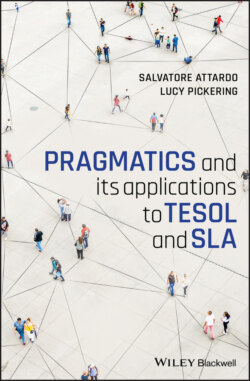Читать книгу Pragmatics and its Applications to TESOL and SLA - Salvatore Attardo - Страница 26
2.3 Can Pragmatics be Taught through Instruction?
ОглавлениеAll the research in this area, and there is plenty, shows that the answer to this question is, in general, yes; and, that instruction is preferable to exposure alone (Gharibeh et al., 2016; Rose, 2005). In addition, recent meta-analyses (Plonsky & Zhuang, 2019; Taguchi, 2015) confirm the long-standing findings that instruction may be most effective if it is explicit and includes metapragmatic explanation (Gavamnia et al., 2014) and communicative practice (Gu, 2011). The next obvious questions are what and how, that is, what areas of pragmatics and how best can we teach them? By far the most work has been done with the teaching of speech acts including requests, compliments, refusals, apologies, complaints, and suggestions among others. Explicit instructional techniques have included “awareness-raising” activities such as role-plays, examining natural discourse, or conversation analysis (Gu, 2011; Nyugen et al., 2012; Soler, 2005; Takahashi, 2001). Much of this work is conducted in EFL contexts with limited opportunity to engage in real-life language use with interlocutors other than learners’ peers and teachers, and researchers have frequently used video input teaching techniques. For example, Alcón Soler and Pitarch (2013) used examples from the TV series Stargate to demonstrate refusal strategies in their successful instructional treatment, and Bagherkazemi (2014) found an improvement in learners’ productions of apologies, requests, and refusals following manipulation of materials from the series Lost and Friends and the movie Doubt. Some implicit feedback in the form of recasts has also been shown to be effective in teaching L2 speech acts (Koike & Pearson, 2005; Martínez-Flor & Fukuya, 2005) and also in improving learners’ confidence in their pragmatic skills (Martínez-Flor, 2006). To a much lesser degree, other areas of pragmatics that have been investigated with regard to instruction include the use of hedging devices, discourse and interactional markers, indirect speech acts, and implicature. As we address these different areas of pragmatics in the following chapters, we’ll look more at what kind of instruction has been used and shown to be effective.
There may also be some drawbacks to classroom instruction. Compared to outside the classroom where learners will engage in multiple roles and relationships with others, the classroom is a far more confined environment with a strict social hierarchy in which much of the discourse is managed by the teacher. This can result in classroom-induced errors (Stenson, 1983). For example, Kitao (1990) reports that Japanese learners rated the request strategy will you? as more polite and used it more often than native speakers did and suggests that this is the result of EFL classroom instruction. Wilkinson (2002) found a similar effect with American study abroad students when they were interacting with their French family hosts. She found a number of examples of sequences that mirrored classroom IRF exchanges (i.e., Initiation–Response–Evaluation) that reflected the “omnipresence of instructional norms” (p. 168) despite the homestay context.
There is also a perennial debate as to whether some things, such as cursing or other kinds of taboo language, should form part of a classroom curriculum (see also Chapter 5 on impoliteness). Traditionally eschewed from language syllabi, more recently, teacher-researchers have begun their own debates regarding whether they want to specifically address these things. Mercury (1995) argues for the importance of assisting ESL learners in their comprehension but not necessarily production of obscene language largely for sociolinguistic purposes:
There is much for ESL students to learn about the social forces behind swearing in English and among English speakers. It is useful still if students only learn to understand for practical reasons why a speaker would choose to use obscenities and when she or he would choose not to.
(p. 29)
Dewaele (2008) also adds a note of caution with regard to production. Following his use of a swearword in his L4 that was not accepted by his native speaker interlocutors, he notes that “My first thought was that this was unfair. I later realized that L2 users do not enjoy the same pragmatic freedom as [native speakers]” (p. 252). Horan (2013) discusses some of the same issues in a foreign language learning context and also addresses production by referencing a number of materials that teachers can find to address the topic.
